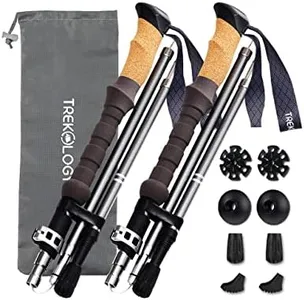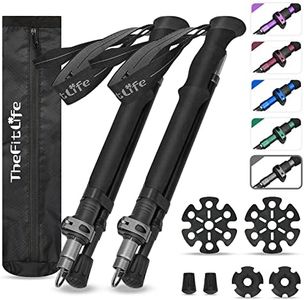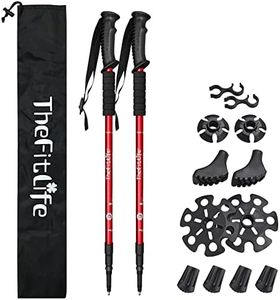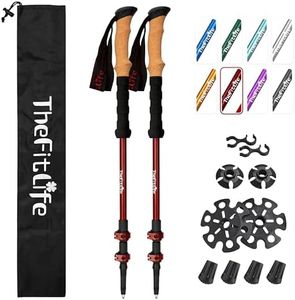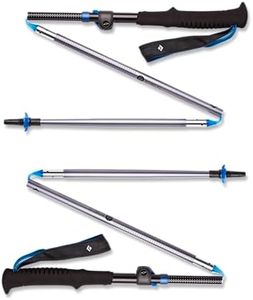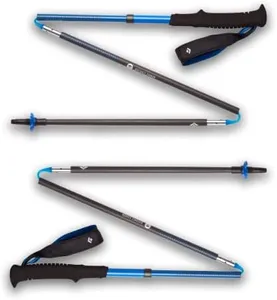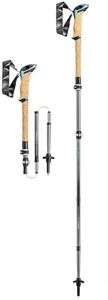We Use CookiesWe use cookies to enhance the security, performance,
functionality and for analytical and promotional activities. By continuing to browse this site you
are agreeing to our privacy policy
10 Best Trekking Poles
From leading brands and best sellers available on the web.Buying Guide for the Best Trekking Poles
Choosing the right trekking poles can make your trekking experience much more comfortable and enjoyable. Trekking poles help with balance, reduce impact on your joints, and provide extra support on tough terrain. The best poles for you will depend on where you plan to hike, how often you go, and what features matter most for your comfort and needs. Navigating the different specs and features will help you find a pair that suits your activities and body best.MaterialMaterial refers to what the poles are made from, usually aluminum or carbon fiber. Aluminum poles are durable and typically heavier, making them a good choice for rough and rocky trails that can put more stress on poles. Carbon fiber poles are lighter and help save energy on long treks, but they may be more vulnerable to cracking under strong force. If you prioritize durability and don't mind extra weight, aluminum is great. If you want to minimize weight for longer outings on well-maintained trails, carbon might be better.
WeightThe weight of trekking poles impacts your comfort, especially if you are trekking long distances or planning to carry the poles often. Lightweight poles are less tiring to use and carry, particularly for multi-day hikes, while slightly heavier poles might feel sturdier and are often less expensive. If you do a lot of trekking, or value ease of movement, go for lighter poles. For shorter or less frequent hikes, weight might be less important.
AdjustabilityAdjustability describes whether you can change the length of the poles. Adjustable trekking poles can be lengthened or shortened to match your height, the terrain, and your activity. Some poles are fixed length, which can be lighter and are usually chosen by users with specialized needs like speed hiking. Adjustable poles are more versatile, making them a good fit if you'll be trekking in a variety of conditions or if more than one person might use the poles. Consider the range of adjustment and locking mechanism for stability and ease of use.
Grip MaterialGrip material is what the handle of the pole is made of, most commonly foam, cork, or rubber. Cork grips absorb sweat and shape to your hand over time, offering natural feel and moderate shock absorption. Foam grips are soft and light, handling moisture well but wearing out a bit faster. Rubber grips insulate well against cold and shocks, but can get slippery with sweat. If you trek mostly in warm conditions, cork or foam is often more comfortable. For cold-weather or wet treks, rubber can be practical.
Foldability and PackabilityFoldability and packability describe how small the poles can be when collapsed. Some poles collapse telescopically, others fold into compact sections. If you travel often or want your poles to fit easily in luggage or a backpack, look for highly packable options. For those who mostly trek from the trailhead and rarely need to stash their poles, packability may not matter as much.
Shock AbsorptionShock absorption refers to built-in mechanisms that reduce the impact transferred to your arms, especially on hard or downhill surfaces. Some poles offer spring-loaded or cushioned sections that act as dampers. If you have sensitive joints, hike often on rocky or paved trails, or descend a lot, poles with shock absorption may make your outings more comfortable. If you favor maximum trail feel or hike on softer ground, this feature may not be needed.
Basket Size and TypeBaskets are the small disks near the tip of the pole that keep them from sinking into mud, snow, or soft ground. Standard baskets are fine for dirt trails, but larger baskets are helpful for snow or mud. If you plan to trek in winter or wet muddy terrain, look for poles with larger or interchangeable baskets. For most non-snowy trails, small baskets are sufficient.
